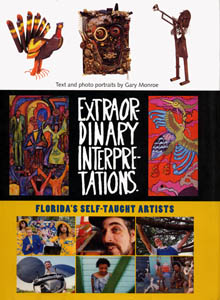|
Where the catalog for the Museum of International Folk Art's Vernacular Visionaries show distinguished itself by its explicit rejection of the survey approach that squeezes essentially random assortments of artists into neat 400-word summaries, Gary Monroe's Extraordinary Interpretations shows that the format still has legs in some contexts. This is not a case where what the common is its presence in a rich donor's collection. Monroe's unifying geographic theme -- self-taught artists of Florida -- still gives the book coherence, if not a common aesthetic. Monroe's sensitive photographs and low-key writing style also help. The fact that there is so much relatively unheralded talent mitigates the superficiality of the survey approach. The overall feeling is reminiscent of the books that served, for many collectors, as introductions to the self-taught, outsider field. The survey format has merit when it is actually introducing something new rather than covering more or less the same ground as the last such survey. However brief the entries in these types of encyclopedic works, they still can convey a few salient points about each artist and maybe an insight or two. The result here is a sense of discovery on nearly every page. Even if you don't find every artistic instance compelling, one after another they generate a sense of excitement. Indeed, the worst thing you can say about the book is that, in some cases, the strict quota of one reproduction per artist is cause for resentment. That's not a problem with the handful of artists who are already well known outside Florida, such as Purvis Young and Woody Long. But when the exposure is not so wide and the evident quality of the art singes from the page, as in the presentation of work by Milton Schwartz and John Gerdes, it definitely leaves the reader anxious for more. Remarkably, even with 62 entries the book is not comprehensive. Those left out include Willie Eaglin, Eric Holmes and Ruby Williams, to name a few. It is testimony to both the book's strengths and limitations that it leaves you wondering, why Florida? Is this book's existence just a matter of geographic happenstance? Or is there something about Florida that encourages self-taught art or constitutes common influences? Perhaps this rich gathering of artists is simply typical in a state of Florida's size, adjusted perhaps for some extra leisure time reflecting an over-representation of retirees. Although Monroe provides no good answers, he does present plenty of evidence that the pool of creativity is by no means exhausted by lists of recognized outsider masters or by the generation of contemporary southern folk artists that is almost passed away.
A version of this review originally appeared in The Outsider magazine, published by Intuit: The Center for Intuitive and Outsider Art.
|
The Latest Stuff | Roadside art | Outsider pages | The idea barn | About | Home
Copyright Interesting Ideas 2004/font>
